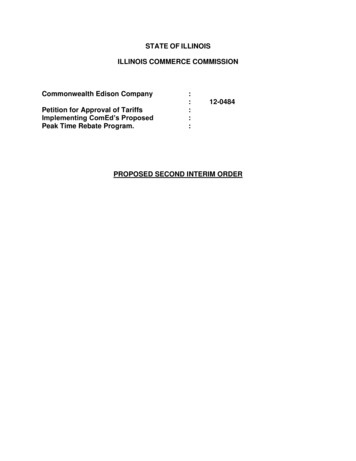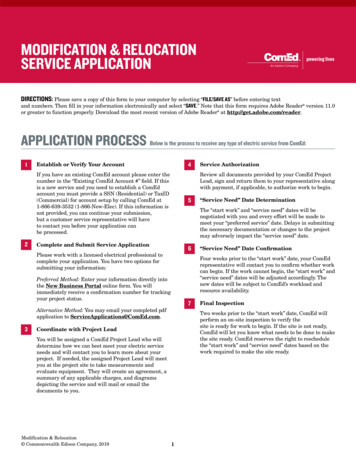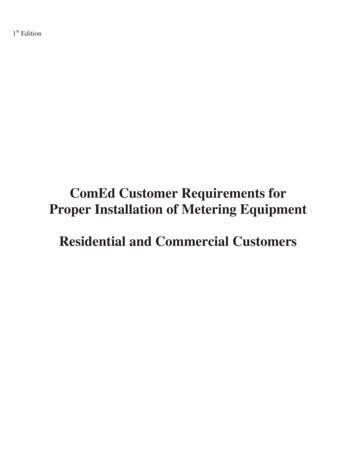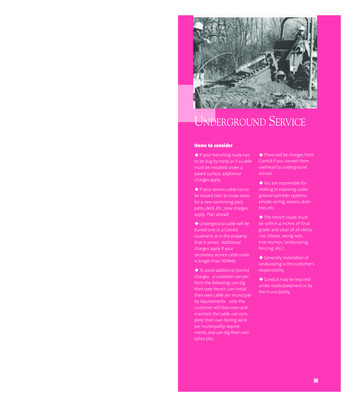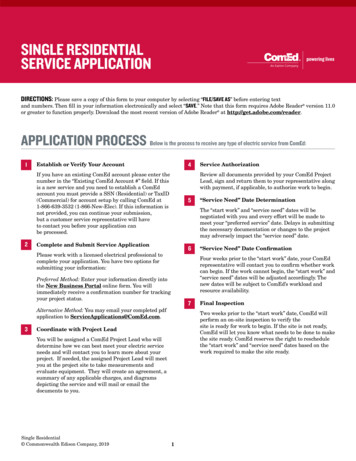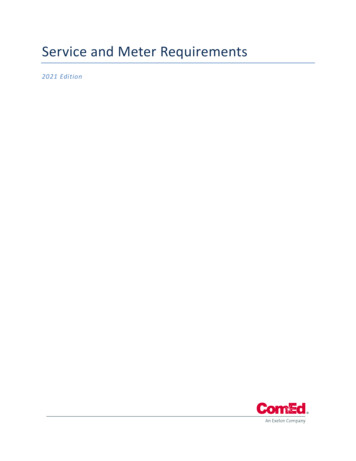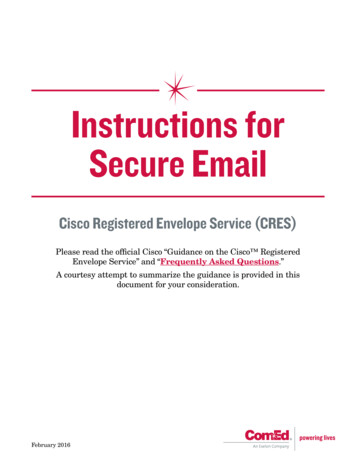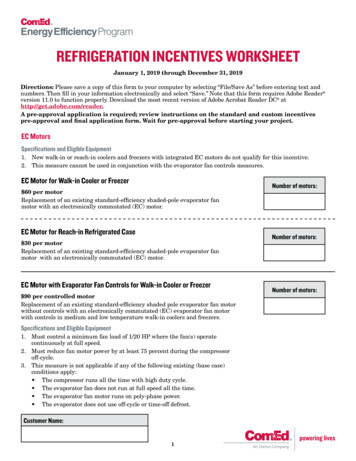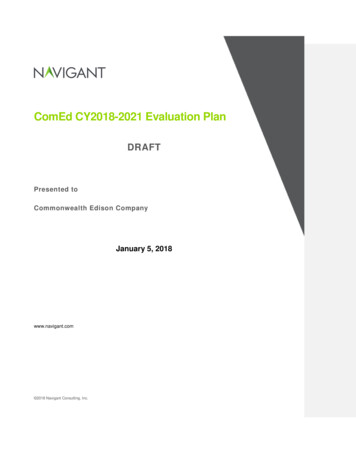
Transcription
ComEd CY2018-2021 Evaluation PlanDRAFTPresented toCommonwealth Edison CompanyJanuary 5, 2018www.navigant.com 2018 Navigant Consulting, Inc.
ComEd CY2018-2021 Evaluation PlanSubmitted to:ComEdThree Lincoln CentreOakbrook Terrace, IL 60181Submitted by:Navigant150 N. Riverside, Suite 2100Chicago, IL 60606Contact:Randy Gunn, Managing Director312.583.5714Randy.Gunn@Navigant.ComJeff Erickson, laimer: This report was prepared by Navigant Consulting, Inc. (“Navigant”) for ComEd based uponinformation provided by ComEd and from other sources. Use of this report by any other party for whateverpurpose should not, and does not, absolve such party from using due diligence in verifying the report’scontents. Neither Navigant nor any of its subsidiaries or affiliates assumes any liability or duty of care tosuch parties, and hereby disclaims any such liability.
ComEd CY2018-2021 Evaluation PlanTABLE OF CONTENTS1.Introduction . 12.Cost-Effectiveness Research . 33.Cross-Cutting Research . 8Exploring Savings . 9Markets and Innovation . 10Process and Customer Engagement . 10Coordinating Future Evaluation Research . 11Active and Future Evaluation Research . 134.Evaluating Pilot Programs . 17Appendix A. C&I Programs Evaluation Plans . 18ComEd AirCare Plus Program CY2018 to CY2021 Evaluation Plan . 18ComEd Business Energy Analyzer Program CY2018 to CY2021 Evaluation Plan . 24ComEd CHP Program CY2018 to CY2021 Evaluation Plan. 28ComEd Custom Program CY2018 to CY2021 Evaluation Plan . 36ComEd Data Centers Program CY2018 to CY2021 Evaluation Plan . 46ComEd Industrial Systems Program CY2018 to CY2021 Evaluation Plan . 56ComEd Instant Discount Program CY2018 to CY2021 Evaluation Plan . 66ComEd LED Street Lighting Program CY2018 to CY2021 Evaluation Plan . 76ComEd, Nicor Gas and Peoples Gas and North Shore Gas Retro-Commissioning Program CY2018to CY2021 Evaluation Plan. 81ComEd Non-Residential New Construction Program CY2018 to CY2021 Evaluation Plan . 90ComEd Operational Efficiency Program CY2018 to CY2021 Evaluation Plan . 97ComEd Public Housing Program CY2018 to CY2021 Evaluation Plan . 101ComEd Rural Small Business Kits Program CY2018 to CY2021 Evaluation Plan . 107ComEd Small Business Energy Savings Program CY2018 to CY2021 Evaluation Plan . 112ComEd Small Business Monitoring-Based Commissioning Program CY2018 to CY2021 EvaluationPlan. 119ComEd Standard Program CY2018 to CY2021 Evaluation Plan. 124ComEd Strategic Energy Management Program CY2018 to CY2021 Evaluation Plan . 131ComEd Voltage Optimization Program CY2018 to CY2021 Evaluation Plan . 137Appendix B. Income Eligible Programs Evaluation Plans . 142ComEd Affordable Housing New Construction Program CY2018 to CY2021 Evaluation Plan . 142ComEd Food Bank LED Distribution Program CY2018 to CY2021 Evaluation Plan. 146ComEd Income Eligible Lighting Discounts Program CY2018 to CY2021 Evaluation Plan . 151ComEd Income-Eligible Multi-Family Retrofit Program CY2018 to CY2021 Evaluation Plan . 156ComEd Income-Eligible Single-Family Retrofit Program CY2018 to CY2021 Evaluation Plan . 160ComEd UIC ERC – Low Income Kit Program CY2018 to CY2021 Evaluation Plan. 164Appendix C. Residential Programs Evaluation Plans . 168ComEd Appliance Rebates Program CY2018 to CY2021 Evaluation Plan . 168ComEd Elementary Energy Education Program CY2018 to CY2021 Evaluation Plan . 174ComEd Fridge and Freezer Recycling Program CY2018 to CY2021 Evaluation Plan . 179ComEd Home Energy Assessment Program CY2018 to CY2021 Evaluation Plan . 186ComEd Home Energy Report (Opower) Program CY2018 to CY2021 Evaluation Plan . 191ComEd HVAC Rebates Program CY2018 to CY2021 Evaluation Plan . 196DRAFTPage i
ComEd CY2018-2021 Evaluation PlanComEd Lighting Discounts Program CY2018 to CY2021 Evaluation Plan . 201ComEd Multi-Family Market Rate Program CY2018 to CY2021 Evaluation Plan . 208ComEd NTC Middle School Kits Program CY2018 to CY2021 Evaluation Plan . 214ComEd and Nicor Gas Residential New Construction Program CY2018 to CY2021 Evaluation Plan. 219ComEd Weatherization Rebates Program CY2018 to CY2021 Evaluation Plan. 224DRAFTPage ii
ComEd CY2018-2021 Evaluation Plan1. INTRODUCTIONThis document presents Navigant’s approach for conducting evaluation research for ComEd over thefour-year period from 2018 to 2021. This document includes evaluation, measurement and verification(EM&V) plans for evaluating ComEd’s energy efficiency programs for program years 2018 through 2021also known as the Energy Efficiency Plan 2018-2021 (EEP 2018-2021) plus a discussion of cross-cuttingevaluation research.Navigant proactively addresses evaluation research according to the Future Energy Jobs Act (FEJA,Public Act 99-0906) and ComEd’s 2018-2021 Energy Efficiency and Demand Response Plan (ComEdPlan 5) while continuing to collaborate with Illinois Stakeholder Advisory Group (IL SAG) and IllinoisCommerce Commission (ICC) staff and contribute to the ongoing continuous improvement of the IllinoisTechnical Reference Manual (IL TRM). As the ComEd energy efficiency and demand response (DR)portfolio has evolved with Plan 5, so too will the methods and approaches for ComEd’s evaluation andevaluation research.Several elements of FEJA drive the need for increased and changed evaluation research, as describedbelow.Focus on CPAS. Under the Future Energy Jobs Act, ComEd’s annual energy savings goals will be basedon CPAS. As indicated in ComEd Plan 5, “the CPAS methodology is a new concept for energy efficiencyin Illinois, and emphasizes a shift to valuing the lifetime savings of the measure versus only the first-year1savings, which was the focus of the prior energy efficiency framework.” In the short term, one focus ofevaluation research is to enable effective evaluation of CPAS. Key evaluation research initiatives includeestimating measure effective useful life (EUL) and measure persistence, both of which are required tocalculate CPAS. Concurrently, the team will be participating in continuous improvement efforts to updatethe IL TRM in conjunction with the IL SAG, such as researching and updating individual measure energysavings estimates to improve accuracy and reduce evaluation risk.New customer segments. FEJA brought Income Eligible and Public Sector customers into ComEd’sportfolio for the first time. ComEd is rolling all Public Sector customers into its existing Business Programsportfolio (except for the Public Housing Authority program which is a standalone C&I program) and so wehave no separate Public Sector evaluation plans. However, we do provide separate Income Eligibleevaluation plans.New RFP Programs. Under FEJA rules, ComEd will issue an RFP in 2018 to request new program ideasfrom external parties. Each of the efforts started under this process will need separate evaluationattention.Timeline. FEJA changed the program year to be based on the calendar year. It specified that ComEd willthdeliver final program year data by January 30 each year and the evaluation reports will be finalized bythApril 30 each year. To meet that deadline (and to improve other aspects of the evaluation) we arethseparating reporting on energy impacts, which will be completed by the April 30 deadline, from reportingon process evaluation research and NTG results. NTG research will be completed by August 1 each year,so that reports can be reviewed and finalized in time for the September 1 initial evaluator NTGrecommendations to SAG required by the Illinois NTG Policy. In 2020, NTG research will be completedone month earlier, by July 1, to inform development of the next EEP. Process evaluation research resultswill be reported as the research is completed so that it is available as soon as possible.1Commonwealth Edison Company’s 2018-2021 Energy Efficiency and Demand Response Plan dated June 30,2017, page 6.DRAFTPage 1
ComEd CY2018-2021 Evaluation PlanNon-Energy Benefits. Navigant will investigate a range of non-energy benefits (NEBs) for the first timefor ComEd.The remainder of this evaluation plan is organized as follows: Cost-Effectiveness Research – Navigant’s work will expand from the previous level of effort Cross-Cutting Research Evaluating Pilot Programs Appendices with individual program evaluation plans, organized by sectorDRAFTComment [A1]: HPC Recommends thatCommission staff, along with the other utilities, andevaluators, consider incorporating NationalStandard Practice Manual (NSPM) framework andprinciples in reviewing and updating this costeffectiveness review. HPC and the NationalEfficiency Screening Project would be veryinterested in bringing examples of how other stateshave applied the NSPM to their own state costeffectiveness testing processes.HPC also suggests that the Technical ReferenceManual (TRM) of the Illinois Energy EfficiencyStakeholder Advisory Group (SAG) be updated toincorporate the NSPM principles. The update andapplication of NSPM principles in 2018 would betterinform the cost effectiveness review, evaluation ofnon-energy benefits and the investigation processdescribed here. Failing to do so now wouldotherwise leave an incomplete cost-effective testinganalysis in place though 2021. Please see HPC’sletter to ComEd of 1-29-18 for more information.Page 2
ComEd CY2018-2021 Evaluation Plan2. COST-EFFECTIVENESS RESEARCHThe primary objectives of the cost-effectiveness review are to: (1) develop a cost model reflectingCommonwealth Edison Company’s (ComEd) costs by program, (2) evaluate the assumptions provided byComEd and included in Navigant’s cost model, (3) after agreement on the cost model and inputs, developthe Total Resource Costs (TRC) for each program, and (4) provide a report with any recommendedimprovements and comments on the costs and the resulting TRCs. As part of Navigant’s evaluation ofComEd energy efficiency and demand response programs, we will develop a cost model and resultingTRCs using an excel based tool and leverage Analytica for developing the final TRCs. Analytica is a toolthat allows Navigant to analyze data at different levels (measure, program and portfolio) and providesgreater data certainty in inputting program costs to run final TRCs.We anticipate that the TRC assumptions review will support evaluation, measurement and verificationand regulatory reporting objectives for ComEd and will also inform future ComEd planning efforts. TheNavigant team will work with ComEd to ensure that the proper data is available for the modeling andevaluation. We will apply the most recent Illinois cost-effectiveness methodology and ICC rulings inreviewing the TRC test calculations.The savings numbers and cost-benefit results included in Navigant’s report will be reflective of the EnergyEfficiency Portfolio Standard (EEPS) portion of the ComEd energy efficiency and demand responseprograms. Any other programs determined to be included in the TRC analysis will also be included.Additionally, for programs that are jointly implemented by ComEd and one or more Illinois gas utilities(including Nicor Gas, Peoples Gas, and/or North Shore Gas), only the electric portion of the programsavings and cost-benefit calculations are included here. The combined joint calculations for the jointprograms will be included in a separate memo attached as an appendix to the report.The Illinois TRC test is defined by the Illinois General Assembly as follows:‘Total resource cost test’ or ‘TRC test’ means a standard that is met if, for an investmentin energy efficiency or demand-response measures, the benefit-cost ratio is greater thanone. The benefit-cost ratio is the ratio of the net present value of the total benefits of theprogram to the net present value of the total costs as calculated over the lifetime of themeasures. A total resource cost test compares the sum of avoided electric utility costs,representing the benefits that accrue to the system and the participant in the delivery ofthose efficiency measures and including avoided costs associated with reduced use ofnatural gas or other fuels, avoided costs associated with reduced water consumption,and avoided costs associated with reduced operation and maintenance costs, as wellas other quantifiable societal benefits, to the sum of all incremental costs of end-usemeasures that are implemented due to the program (including both utility and participantcontributions), plus costs to administer, deliver, and evaluate each demand-sideprogram, to quantify the net savings obtained by substituting the demand-side programfor supply resources. In calculating avoided costs of power and energy that an electricutility would otherwise have had to acquire, reasonable estimates shall be included offinancial costs likely to be imposed by future regulations and legislation on emissions ofgreenhouse gases. In discounting future societal costs and benefits for the purpose ofcalculating net present values, a societal discount rate based on actual, long-termTreasury bond yields should be used. Notwithstanding any to the contrary, the TRC testDRAFTPage 3Comment [A2]: HPC encourages the IllinoisCommerce Commission to apply the NationalStandard Practice Manual (NSPM) framework andprinciples to inform the range of impacts (costs andbenefits, both utility system and non utility systemimpact) to consider and include in the CE test, theresult of which can help to inform potentialimprovements to the current TRC test to ensurealignment with Illinois’ applicable policiesHPC Recommends that Commission staff, along withthe other utilities, and evaluators, considerincorporating NSPM framework and principles inreviewing and updating this ComEd costeffectiveness review. HPC and the NationalEfficiency Screening Project would be veryinterested in bringing examples of how other stateshave applied the NSPM to their own state costeffectiveness testing processes.HPC also suggests that the Technical ReferenceManual (TRM) of the Illinois Energy EfficiencyStakeholder Advisory Group (SAG) be updated toincorporate the NSPM principles. The update andapplication of NSPM principles in 2018 would betterinform the Navigant and Analytica cost effectivenessmodel and review process.Comment [A3]: HPC Recommends thatCommission staff, along with the other utilities, andevaluators, consider incorporating NSPM frameworkand principles in reviewing and updating the ComEdcost effectiveness review for other quantifiablesocietal benefits. The approach to this portion ofthe statute is not clearly described elsewhere in theEvaluation Plans.
ComEd CY2018-2021 Evaluation Planshall not include or take into account a calculation of market price suppression effects ordemand reduction induced price effects. 2The Illinois TRC test was modified by the Illinois General Assembly in December 2016 (for applicationstarting in CY2018) to explicitly include a societal discount rate, avoided water and avoided operationsand maintenance costs, and exclude market price suppression effects. The Illinois test makes it clear thatthe TRC requirement for plan approval is only at the portfolio level and excludes low income programs.Individual measures need not be cost effective. The Illinois TRC test differs from traditional TRC tests inits requirement to include a reasonable estimate of the financial costs associated with future regulationsand legislation on the emissions of greenhouse gases (GHG). This difference adds an additional benefitto investments in efficiency programs that are typically included in the Societal Test in other jurisdictions.Illinois TRC Equation used in the AssessmentThe equation that will be used to calculate the Illinois TRC is presented below:Equation 1 – Illinois TRCBCRILTRC BILTRC / CILTRCWhere,BCRILTRCBILTRCCILTRC Benefit-cost ratio of the Illinois total resource cost testPresent value of benefits of a Illinois program or portfolioPresent value of costs of a Illinois program or portfolioThe benefits of the Illinois TRC are calculated using the following equation:Equation 2 – IL TRC BenefitsUAEPt UATDt UAAt EBt N UAC at PAC at RC(1 d ) t 1(1 d ) t 1t 1t 1NB ILTRC The costs of the Illinois TRC are calculated using the following equation:Equation 3 - IL TRC CostsNC ILTRC t 1PRCt PICt PEAM t PCN t UICt(1 d ) t 1Where benefits are defined as:UAEPtUATDtUAAtEBtUACatPACatRC Utility avoided electric production costs in year tUtility avoided transmission and distribution costs in year tUtility avoided ancillary costs in year tEnvironmental Benefits in year tUtility avoided supply costs for the alternate fuel in year tParticipant avoided costs in year t for alternate fuel devicesNPV of replacement costs of incandescent equivalentsAnd costs are defined as:2See 0906.htmDRAFTPage 4
ComEd CY2018-2021 Evaluation PlanPRCtPICtPEAMtPCNUICtd Program Administrator program costs in year t Program Implementation costs in year t Program Evaluation, Measurement & Verification (EM&V), Advertising andMiscellaneous costs in year t Net Participant costs Utility increased supply costs in year t Utility weighted average cost of capital, used as discount rateThe Illinois TRC test allows for utilities to claim as a benefit the net present value (NPV) of the avoidedcost of purchasing incandescent bulbs that accrues to program participants because of the significantlylonger lifetimes of efficient CFLs and LED light bulbs. In general, the avoided cost per bulb is determinedby comparing the estimated useful life of efficient and baseline bulbs to determine the number of baselinebulb purchases that are avoided. Based on the average purchase price of baseline bubs, an NPV isdetermined by discounting the value of these avoided purchases over the course of the lifetime of theefficient bulb. The Illinois TRM provides deemed NPV values per bulb based on efficient bulb-type, sockettype (commercial or residential), and lumen range. These benefits were included in the programcalculations provided below.UCT Equation used in the AssessmentThe results of the Utility Cost Test are also presented in Section 2 of this report. The UCT (a subset of theProgram Administrator Cost Test) approaches cost effectiveness from the perspective of the utility. Itdetermines whether the energy supply and capacity costs avoided by the utility exceed the overhead andcost outlays that the utility incurred to implement energy efficiency programs. The structure of thecalculation is similar to the IL TRC, with a few key changes. Since the UCT is primarily focused on utilityoutlays, incentives paid by the utility to either participants or third party implementers are included in thecalculation in place of incremental or participant costs. Additionally, since non-energy benefits accrue tosociety rather than to the utility implementing energy efficiency programs, these benefits are not includedin the UCT formula.Using the equation terms previously defined for the IL TRC equation, the UCT equation that will be usedis defined as:Equation 4 – UCTBCRUCT BUCT / CUCTWhere,BCRUCTBUCTCUCT Benefit-cost ratio of the Utility Cost TestPresent value of benefits to a utility of a program or portfolioPresent value of costs to a utility of a program or portfolioThe benefits of the UCT are calculated using the following equation:Equation 5 – UCT BenefitsUAEPt UATDt UAAt N UACat t 1(1 d )t 1t 1t 1 (1 d )NBUCT The costs of the UCT are calculated using the following equation:DRAFTPage 5
ComEd CY2018-2021 Evaluation PlanEquation 6 - UCT CostsNCUCT t 1PRC t PICt PEAM t PIN t UICt(1 d ) t 1Where the new term, PINt, is defined as the program incentives provided by the utility in year t.Cost-Effectiveness Data RequirementsThe data points needed to conduct the Illinois TRC test are provided in Table 1, below, and are dividedinto generic and program specific categories. The program specific data points are further subdivided intothose that are provided by ComEd versus those that are a result of the Navigant’s evaluation activities.Comment [A4]: HPC encourages the IllinoisCommerce Commission to apply the NationalStandard Practice Manual (NSPM) frameworkand principles to inform the range of impacts(costs and benefits, both utility system and nonutility system impact) to consider and include inthis portion of the TRC analysis.Table 1. Data points needed to conduct EEPS TRCCategoryGenericProgramSpecificData Point Avoided Energy Costs ( /kWh)Avoided Capacity Costs ( /kW-year)Discount RateEscalation RatesLine LossesAvoided GHG Emission CostsParticipants / Measure CountVerified Ex-Post Energy Savings (kWh)Verified Ex-Post Capacity Savings (kW)Realization RateNet to Gross RatioMeasure lifeNon-Incentive CostsUtility Incentive CostsIncremental Costs (Gross)Incremental Costs (Net)SourceComEdNavigantComEdSource: Navigant analysisOur cost model will build-up from the measure and project level, cost detail by program which will roll-upinto a portfolio level cost analysis. That cost analysis will be used to run the TRCs for each program so toarrive at final program TRCs and finalize a portfolio-level TRC.Evaluation ApproachThis four-year evaluation plan summary identifies tasks by year on a preliminary basis for CY2018 CY2021 (Table 2). Activities for CY2019 are subject to change based upon the demands of the portfolioand other factors, and during the program year as program circumstances are better known.DRAFTPage 6
ComEd CY2018-2021 Evaluation PlanTable 2. Four Year Evaluation Plan Summary for the Cost-Effectiveness AssessmentActivityCY2018CY2019-2021ComEd Provides Cost Data and AssumptionsComEdComEdAnalysis of Cost Detail and Related AssumptionsNavigant Develops Cost ModelNavigant Develops Cost ModelRun Cost-Effectiveness Calculations Using ModelNavigant Runs TRC CalculationsNavigant Runs TRC CalculationsDraft Cost-Effectiveness ReportNavigantNavigantEvaluation ScheduleTable 3 below provides the schedule for key deliverables and data transfer activities. Adjustments will bemade, as needed, as assessment and evaluation activities progress or changes in program delivery maybe required.Plan start and delivery dates will be the same in most cases for CY2018 and subsequent years, exceptfor potential changes in the timelines and specific calendar dates in CY2019 and following years.Navigant will strive to provide timely delivery of the results outlined above, but all are contingent uponComEd delivering timely cost detail and proper back-up assumption detail to Navigant.Table 3. Schedule – Key Deadlines in CY2018Activity/DeliverablesResponsible PartyDate DeliveredCost Assumptions and DetailComEdMay 15, 2019 (annually) *Navigant Develops Initial Cost ModelNavigantJuly 1, 2019 (annually)Iterative Cost and Assumptions Discussions w/ComEdComEd / NavigantJuly-August 2019Finalize Cost ModelNavigantAugust 20, 2019 (annually)Navigant Develops Initial TRCsNavigantSeptember 15, 2019 (annually)Discussion of Initial TRCsComEd / NavigantSeptember 20, 2019 (annually)Finalize TRCsNavigantSeptember 30, 2019 (annually)Navigant Draft TRC Report – Delivered (15 Bus Day R’vw)NavigantOctober 8, 2019 (annually)Comments on Draft TRC Report due from PartiesComEd / NavigantOctober 29, 2019 (annually)Navigant Redraft of TRC Report Based on CommentsNavigantNovember 7, 2019 (annually)Final Report to ComEd and SAGNavigantNovember 19, 2019 (annually)*Note: Receipt of the initial assumption and cost data from ComEd is the initial step and without timely receiptof data and detail, the entire schedule shifts by an equal amount of time – each date will be delayed.DRAFTPage 7
ComEd CY2018-2021 Evaluation Plan3. CROSS-CUTTING RESEARCHNavigant will perform cross-cutting research to support improving the programs and improving the TRM.This research is geared toward three general topic areas: exploring savings, markets and innovation, andprocess and customer engagement. These three topic areas are designed to mirror priorities listed in theComEd Plan 5 settlement stipulation. Figure 1 includes the evaluation research topic areas and severalkey evaluation research questions within each area.Figure 1 Evaluation Research Topic AreasEXPLORING SAVINGS How can evaluation research improve IL TRM input parameter assumptions? What are realistic effective useful life (EUL) and persistence estimates for measures? What savings are associated with new behavioral and thermostat measures? What innovative evaluation approaches can be applied to custom measures? What are typical end-use load shapes for high priority measures? What are the effects of non-energy benefits (NEBs) in the income-eligible market sectorand other market sectors?MARKETS AND INNOVATION How can ComEd leverage advanced metering infrastructure (AMI) data for evaluation? What approaches are other utilities using to evaluate income-eligible programs? How are other utilities in the country adapting evaluation approaches to accommodateinnovative program designs and delivery mechanisms? How do other industries evaluate progress and results quickly and accurately, and canthese approaches improve energy efficiency evaluation?PROCESS AND CUSTOMER ENGAGEMENT In what evaluation areas could expanding the use of email or electronic surveys improveresponse rates? What are customer and/or trade ally geographic participation patterns? Are thereunderserved areas or patterns that could be categorized by customer type to identifyopportunities to increase participation? What opportunities are available to enhance the customer experience for income-eligibleprograms, public sector programs, or other customer segments? How are utilities and other innovative companies across the world connecting with theircustomers, and how can ComEd apply those concepts to aid in evaluation?Source: NavigantCoordinating Evaluation ResearchNavigant has identified several evaluation research tasks for the 2018-2021 period, many of which arecurrently in planning or underway. The team plans to continuously revisit current and planned evaluationDRAFTPage 8
ComEd CY2018-2021 Evaluation Planresearch to ensure it aligns with ComEd’s evaluation as new programs, customer segments, andtechnologies emerge and require attention, while not losing sight of the core goals of evaluation research.Navigant plans to work with ComEd, the IL TRM administrator, and ICC staff to develop tools andprocesses for quickly identifying new priorities, reviewing them alongside existing evaluation researchtopics, and determining a path forward that meets the evolving evaluation research objectives.Regular communication and clear processes for launching new evaluation research and modifyingongoing study objectives midstream will ensure the team addresses current and future evaluationresearch objectives efficiently. The second section of this plan outlines Navigant’s communicationstrategy, including weekly tracker updates, monthly telephone conference calls, periodic face-to-facemeetings, and continued participation in the IL SAG and the Technical Advisory Committee (TAC).Navigant has activated several high priority evaluation research initiatives, such as identifyingopportunities to leverage AMI data and assessing the accuracy of current EUL estimates in the IL TRMgiven the transition to CPAS goals. Additionally, the team has initiated planning for other evaluationresearch activities in the next year, such as NEB studies and developing load profiles to update the ILTRM. Navigant expects to conduct other evaluation research during the ComEd Plan 5 timeframe.However, many factors could affect the scope and timing of these activities; therefore, they are no
ComEd energy efficiency and demand response programs, we will develop a cost model and resulting TRCs using an excel based tool and leverage Analytica for developing the final TRCs. Analytica is a tool that allows Navigant to analyze data at different levels (measure, program and portfolio) and provides .
